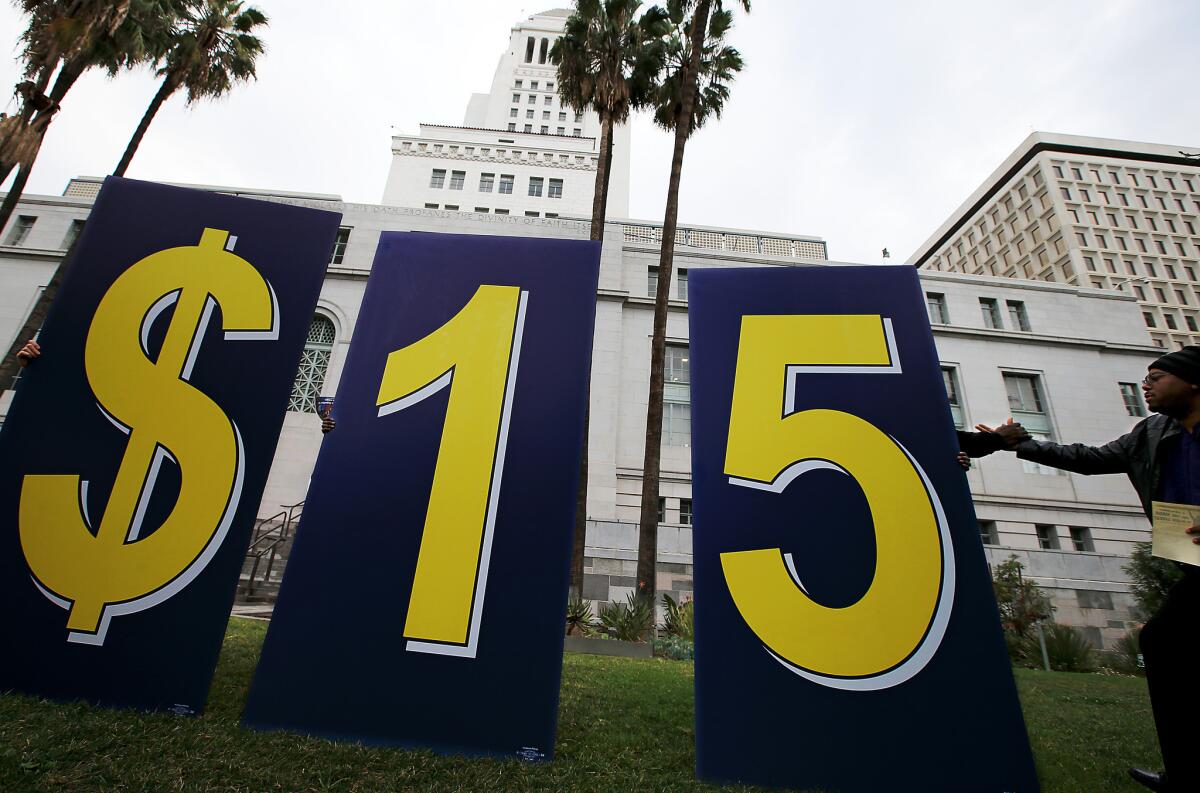Editorial: It’s long past time to raise the national minimum wage

It’s been a decade since workers earning the federal minimum wage got a raise. That’s the longest stretch of time that the country’s lowest paid workers have gone without an increase since President Franklin D. Roosevelt signed the Fair Labor Standards Act in 1938, which established the right to a minimum wage.
Even if the current $7.25 an hour sounded like decent pay in 2009, it’s woefully insufficient today for anyone working full-time, especially if they’re in or near a city. Congress should raise the minimum wage as one step toward lifting working people out of poverty.
For the record:
1:35 p.m. July 18, 2019An earlier version of this editorial incorrectly stated that the federal minimum wage would be $10.15 today if it had been adjusted for inflation since 2009. It would be at $10.15 today if the minimum in 1968, $1.60, had been steadily adjusted for inflation.
The only question is how far it should go.
The House of Representatives is set to vote this week on the Raise the Wage Act, which would increase the federal minimum to $15 an hour by 2024. The bill is likely to pass the Democratic-controlled House, but it’s expected to stop there — at least in its current form. The Republican-controlled Senate is unlikely to take up the bill, and President Trump has vacillated on whether he supports raising the minimum wage.
That’s a shame. Poverty shouldn’t be a partisan issue. And while the two parties disagree on how to move Americans up the economic ladder and what role the government should play, there is broad agreement that working people should get paid at least enough to afford the essentials for themselves and their families.
A full-time worker making $7.25 an hour earns about $15,000 a year. That is below the poverty line for a single parent with one child; in fact, it’s less than the amount needed to pay the average rent for an apartment in this country. If the minimum wage had risen with inflation since 1968, it would be $10.15 an hour, or $21,000 a year for a full-time worker. Let’s not kid ourselves — it’s still hard to make a living on $10 an hour, but at least it would be a step above the poverty line for that single parent.
Yet even with the widespread recognition that the federal minimum wage is too low, there still needs to be more discussion across the aisle about how to raise it in the manner that helps the most workers with the fewest negative impacts. Because there are trade-offs in a mandated wage hike.
Although there is substantial evidence that modest increases in the minimum wage don’t upend the job market, there is little agreement on what exactly is a “modest increase.” The challenge for lawmakers is to find the sweet spot, or the highest point to which base pay can be raised before employers reduce hours and trim staff enough to undercut the benefit of the minimum wage increase.
There are also effects on the broader economy to consider: A wage increase tends to boost consumer spending, but it can also raise the cost of some goods and services, particularly the ones supplied by low-skill workers and companies with thin profit margins.
Does an increase to $15 an hour by 2024, which would double the minimum wage in five years, hit the sweet spot? The Congressional Budget Office estimated that the Raise the Wage Act would boost pay for 27 million Americans. That includes 17 million who would otherwise earn less than $15 an hour in 2024 and 10 million who would earn more than $15 but would probably get a bump in pay as well.
The trade-off? An estimated 1.3 million workers would lose their jobs. That doesn’t sound like mass unemployment, but the effects could be felt disproportionately in areas already struggling with high poverty. There’s little research on what happens when large wage increases are imposed on communities with high unemployment, extensive low-wage workforces and low costs of living.
We’ve supported raising the minimum wage in Los Angeles and California, which will hit $15 an hour in 2020 and 2022, respectively. The reality is that $15 an hour might be essential to live in L.A. or other high-cost regions, but may be unsustainable in Mississippi. However, there’s still a need for a new national minimum wage to raise the wage floor — clearly, the current $7.25 is not a fair or economically justifiable baseline.
Washington gridlock has held the lowest-wage workers hostage for a decade. It’s time to raise the minimum wage.
More to Read
A cure for the common opinion
Get thought-provoking perspectives with our weekly newsletter.
You may occasionally receive promotional content from the Los Angeles Times.






